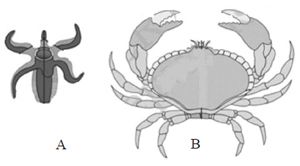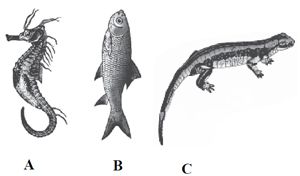The given figures of animals (A & B) are distinguished on the basis of symmetry. Select the correct option which shows the type of symmetry and its description against the animals.

A : Biradial, organisms is divided into unequal halves by any plane through the central axis.
B: Bilateral, body is divided into equivalent right and left halves by only one plane.
A: Asymmetrical, organisms is not divided into equal halves by any plane through the central axis.
B: Radial, in which any plane passing through the central axis of the body divides the organism into two identical halves.
Correct Answer :
B. B: Bilateral, body is divided into equivalent right and left halves by only one plane.
Animals (like annelida and amphibia) that are bilaterally symmetric have mirror symmetry in the sagittal plane, which divides the body vertically into left and right halves, with one of each sense organ and limb pair on either side. Bilateral symmetry developed due to cephalization.
Related Questions
Which of the following belong to phylum arthropoda?
Bombyx and Apis
Laccifer and Anopheles
Locusta and Limulus
All of the above
Match the terms/feature given in column I with their examples given in column II and select the correct match from the option given below.
| Column-I | Column-II |
|---|---|
| (Term/Feature) | (Examples) |
| A. Gregarious pest | i. Hirudinaria |
| B. Vector | ii. Planaria |
| C. Oviparous with | iii. Sepia indirect development |
| D. Metameres | iv. Aedes |
| E. High regeneration | v. Locust capacity |
A - i, B - ii, C - iii, D - iv, E - v
A - iii, B - v, C - ii, D - iv, E - i
A - iii, B - i, C - v, D - ii, E - iv
A - v, B - iv, C - iii, D - i, E - ii
Tracheae of cockroach and mammal are similar in having
paired nature.
non-collapsible walls.
ciliated inner lining.
origin from head.
Refer the figures A, B and C and choose the correct option which shows animals that regulate buoyancy with the help of air bladder.

A and B
A and C
B and C
All of the above.
Which of the follwoing statement(s) is/are correct?
(i) Organ systems in different group of animals show various patterns of complexities.
(ii) The digestive system in platyhelminthes has only a single opening to the outside of the body that serve as both mouth and anus, and is hence called complete.
(iii) In open type of circulatory system, the blood is pumped out of the heart and the cells and tissues are directly bathed in it.
(iv) In closed type, the blood is circulated through a series of vessels of varying diameters (arteries, veins and capillaries).
Only (i)
Both (ii) and (iii)
(i), (iii) and (iv)
All of these
Which of the following animals are bilaterally symmetrical?

1 & 2
2 & 4
3 & 4
1 & 3
Refer the types of cells present in some animals. Each cell is specialized to perform a single specific function except
Cnidocytes
Choanocytes
Interstitial cells
Gastrodermal cells
Which of the following pairs of animals are similar to each other pertaining to the feature stated against them?
Pteropus and Ornithorhyncus - Viviparity
Garden lizard and crocodile - Three chambered heart
Ascaris and Ancylostoma - Metameric segmentation
Sea horse and flying fish - Cold blooded (poikilothermal)
The transition from aquatic to terrestrial lifestyles required many adaptations in the vertebrate lineage. Which of the following is not one of those adaptations ?
Switch from gill respiration to air-breathing lungs.
Improvements in water resistance of skin.
Alteration in mode of locomotion.
Development of feathers for insulation.
Column I contains zoological names of animals and column II contains their common name. Match the following and choose the correct option.
| Column -I | Column- II |
|---|---|
| A. Physalia | I. Sea anemone |
| B. Meandrina | II. Brain coral |
| C. Gorgonia | III. Sea fan |
| D. Adamsia | IV. Portuguese man-of-war |
A III; B II; C I; D IV
A IV; B III; C II; D I
A IV; B II; C III; D I
A II; B III; C I; D IV
Hemichordates have now been placed with the nonchordates, close to echinoderms, because true
notochord is absent.
pharyngeal gill-slits are lacking.
dorsal nerve cord is absent.
heart is lacking.
The given figures (A & B) shows the germinal layer. The animals having structures shown in the figures are respectively called

diploblastic, triploblastic
triploblastic, diploblastic
diploblastic, diploblastic
triploblastic, triploblastic
Which of the following is a connecting link between invertebrates and non-invertebrates?
Sphenodon
Balanoglossus
Tadpole larva
Crocodile
In amphibians, respiration occurs through
gills
lungs
skin
all of these
Which of the following class is being correctly described by given statements (i - iv)?
(i) All living members of this class are ectoparasites on some fishes.
(ii) They have a sucking and circular mouth without jaws.
(iii) Circulation is of closed type.
(iv) They are marine but migrate for spawning to fresh water. After spawing, within a few days they die.
Cyclostomata
Chondrichthyes
Osteichthyes
Amphibia
Which of the following feature is not correct regarding the figure given below?

It is an aquatic form.
Circulatory system is of open type.
It possesses parapodia for swimming.
Neural system consists of paired ganglia connected by lateral nerves to a double ventral nerve cord.
Which of the following group of animals belongs to the same phylum?
Earthworm, pinworm, tapeworm
Prawn, scorpion, Locusta
Sponge, Sea anemone, starfish
Malarial parasite, Amoeba, mosquito
Which of the following is a chordate feature and not shared by the non-chordates ?
Metamerism
Axial organization
Bilateral symmetry
Pharyngeal gill slits
Read the following statements and answer the question.
(i) They are exclusively marine, radially symmetrical, diploblastic organisms with tissue level of organisation.
(ii) Body bears eight external rows of ciliated comb plates, which help in locomotion.
(iii) Digestion is both extracellular and intracellular.
(iv) Reproduction takes place only by sexual means.
Which of the following phylum is being described by above statements?
Platyhelminthes
Arthropoda
Mollusca
Ctenophora
Which one of the following features is common in silverfish, scorpion, dragonfly and prawn?
Three pairs of legs and segmented body.
Chitinous cuticle and two pairs of antennae.
Jointed appendages and chitinous exoskeleton.
Cephalothorax and tracheae.
Which of the following group of animals reproduces only by sexual means?
Ctenophora
Cnidaria
Porifera
Protozoa
Flame cells present in platyhelminthes, are specialized in
respiration and absorption.
osmoregulation and circulation.
respiration and excretion.
osmoregulation and excretion.
In phylum arthropoda, excretion takes place through
nephridia
flame cells
malphigian tubules
gills
Which of the following statement is incorrect?
Platyhelminthes has incomplete digestive system.
In coelenterates, the arrangement of cells is more complex.
Nereis is monoecious but earthworms and leeches are dioecious.
Simple and compound eyes are present in the animals of those phylum whose over two-thirds of all named species on earth are arthropods.
Which of the following statement(s) is/are correct regarding phylum aschelminthes?
(i) The body is circular in cross-section hence the name roundworms.
(ii) Alimentary canal is complete with a well-developed muscular pharynx.
(iii) Sexes are separate (dioecious), i.e., males and females are distinct.
(iv) Nephridia help in osmoregulation and excretion.
(i) and (ii)
(iii) and (iv)
(i), (ii) and (iii)
All of these
Which of the following sets of animals give birth to young ones?
Platypus, Penguin, Bat, Hippopotamus.
Shrew, Bat, Cat, Kiwi.
Kangaroo, Hedgehog, Dolphin, Loris.
Lion, Bat, Whale, Ostrich.
Identify the figure with its correct name and phylum.

Cucumaria – Echinodermata
Ascidia – Urochordata
Balanoglossus – Hemichordata
Hirudinaria – Annelida
Which of the following statements is without exception in sponges ?
They all have calcareous spicules.
They have high regenerative power.
They are found only in marine water.
They are all radially symmetrical.
Identify the correct characteristics of porifera.
- Commonly known as sea walnuts.
- Presence of ostia and collar cells.
- Exhibit tissue level of characteristics.
- It is the largest phylum of animal kingdom.
- The body is supported by spicules and sponging fibers.
- Contains cnidocytes which is used for defense, anchorage and capturing of prey.
(ii), (v) only
(i), (ii), (vi) only
(i), (ii), (iii), (iv) only
All of these.
Match the features given in column I with their examples given in column II and choose the correct match from the option given below.
| Column-I | Column-II |
|---|---|
| (Features) | (Examples) |
| A. Pseudocoelomates | a. Hydra, Adamsia |
| B. Diploblastic | b. Ctenoplana, Aurelia |
| C. Cellular level of | c. Ascaris, Wuchereria organization |
| D. Radial symmetry | d. Sycon, Spongilla |
| E. Metamerism | e. Pheretima, Neries |
A - e, B - b, C - d, D - c, E - a
A - c, B - a, C - d, D - b, E - e
A - b, B - a, C - c, D - e, E - d
A - c, B - b, C - d, D - a, E - e
